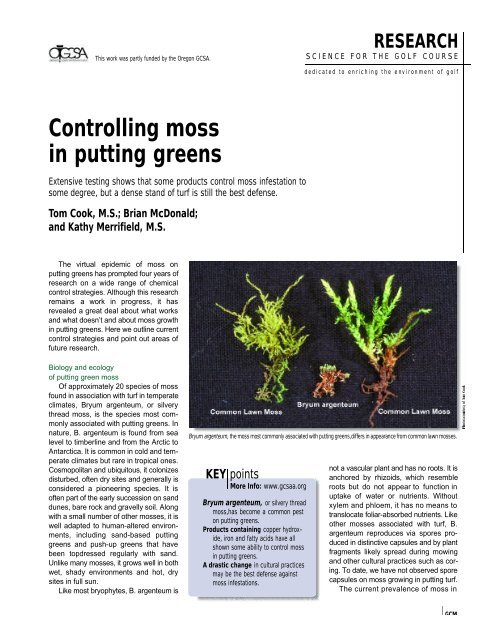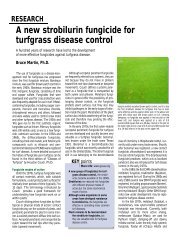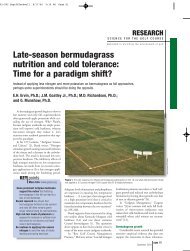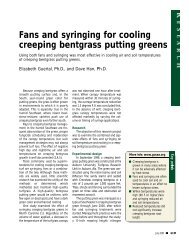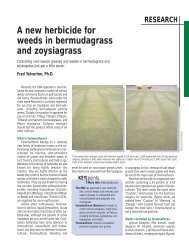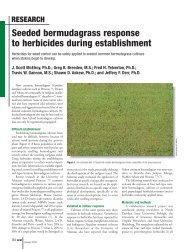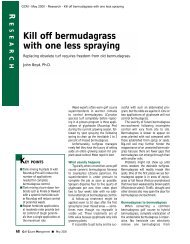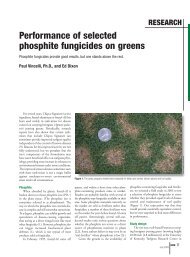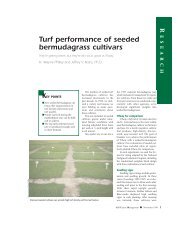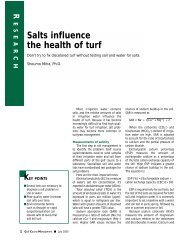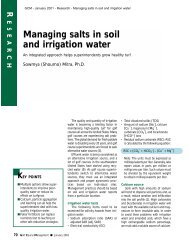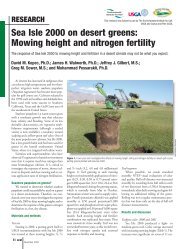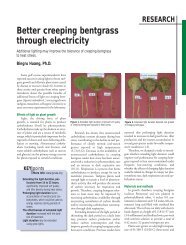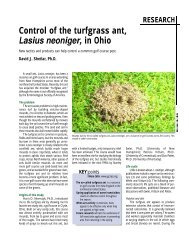Controlling moss in putting greens - GCSAA
Controlling moss in putting greens - GCSAA
Controlling moss in putting greens - GCSAA
Create successful ePaper yourself
Turn your PDF publications into a flip-book with our unique Google optimized e-Paper software.
This work was partly funded by the Oregon GCSA.RESEARCHS C I E N C E F O R T H E G O L F C O U R S Ed e d i c a t e d t o e n r i c h i n g t h e e n v i r o n m e n t o f g o l f<strong>Controll<strong>in</strong>g</strong> <strong>moss</strong><strong>in</strong> putt<strong>in</strong>g <strong>greens</strong>Extensive test<strong>in</strong>g shows that some products control <strong>moss</strong> <strong>in</strong>festation tosome degree, but a dense stand of turf is still the best defense.Tom Cook, M.S.; Brian McDonald;and Kathy Merrifield, M.S.The virtual epidemic of <strong>moss</strong> onputt<strong>in</strong>g <strong>greens</strong> has prompted four years ofresearch on a wide range of chemicalcontrol strategies. Although this researchrema<strong>in</strong>s a work <strong>in</strong> progress, it hasrevealed a great deal about what worksand what doesn’t and about <strong>moss</strong> growth<strong>in</strong> putt<strong>in</strong>g <strong>greens</strong>. Here we outl<strong>in</strong>e currentcontrol strategies and po<strong>in</strong>t out areas offuture research.Biology and ecologyof putt<strong>in</strong>g green <strong>moss</strong>Of approximately 20 species of <strong>moss</strong>found <strong>in</strong> association with turf <strong>in</strong> temperateclimates, Bryum argenteum, or silverythread <strong>moss</strong>, is the species most commonlyassociated with putt<strong>in</strong>g <strong>greens</strong>. Innature, B. argenteum is found from sealevel to timberl<strong>in</strong>e and from the Arctic toAntarctica. It is common <strong>in</strong> cold and temperateclimates but rare <strong>in</strong> tropical ones.Cosmopolitan and ubiquitous, it colonizesdisturbed, often dry sites and generally isconsidered a pioneer<strong>in</strong>g species. It isoften part of the early succession on sanddunes, bare rock and gravelly soil. Alongwith a small number of other <strong>moss</strong>es, it iswell adapted to human-altered environments,<strong>in</strong>clud<strong>in</strong>g sand-based putt<strong>in</strong>g<strong>greens</strong> and push-up <strong>greens</strong> that havebeen topdressed regularly with sand.Unlike many <strong>moss</strong>es, it grows well <strong>in</strong> bothwet, shady environments and hot, drysites <strong>in</strong> full sun.Like most bryophytes, B. argenteum isB ryum argenteum, the <strong>moss</strong> most commonly associated with putt<strong>in</strong>g gr e e n s ,d i fers <strong>in</strong> appearance from common lawn <strong>moss</strong>es.KEY po<strong>in</strong>tsMore Info: www.gcsaa.orgBryum argenteum, or silvery thread<strong>moss</strong>,has become a common peston putt<strong>in</strong>g <strong>greens</strong>.Products conta<strong>in</strong><strong>in</strong>g copper hydroxide,iron and fatty acids have allshown some ability to control <strong>moss</strong><strong>in</strong> putt<strong>in</strong>g <strong>greens</strong>.A drastic change <strong>in</strong> cultural practicesmay be the best defense aga<strong>in</strong>st<strong>moss</strong> <strong>in</strong>festations.not a vascular plant and has no roots. It isanchored by rhizoids, which resembleroots but do not appear to function <strong>in</strong>uptake of water or nutrients. Wi t h o u txylem and phloem, it has no means totranslocate foliar-absorbed nutrients. Likeother <strong>moss</strong>es associated with turf, B.argenteum reproduces via spores produced<strong>in</strong> dist<strong>in</strong>ctive capsules and by plantfragments likely spread dur<strong>in</strong>g mow<strong>in</strong>gand other cultural practices such as cor<strong>in</strong>g.To date, we have not observed sporecapsules on <strong>moss</strong> grow<strong>in</strong>g <strong>in</strong> putt<strong>in</strong>g turf.The current prevalence of <strong>moss</strong> <strong>in</strong>GCM
RESEARCHputt<strong>in</strong>g <strong>greens</strong> probably reflects recenttrends <strong>in</strong> putt<strong>in</strong>g green culture, <strong>in</strong>clud<strong>in</strong>gextremely low mow<strong>in</strong>g, m<strong>in</strong>imal nitrogenf e r t i l i z e r, <strong>in</strong>creased use of sand grow<strong>in</strong>gmediums, <strong>in</strong>tense sand topdress<strong>in</strong>g andloss of mercury fungicides, which werehighly toxic to <strong>moss</strong>. It occurs on bothbentgrass and Poa annua <strong>greens</strong> but isby far a bigger problem on sand-basedbentgrass <strong>greens</strong>. We have found significantpopulations on first-year <strong>greens</strong>on new golf courses. It often shows upfirst <strong>in</strong> weak areas such as ridges andmounds where grass is th<strong>in</strong> because ofscalp<strong>in</strong>g or drought stress. It aggressivelycolonizes low, wet areas andthrives on soil-based <strong>greens</strong> with shallowlayers of sand built up by topdress<strong>in</strong>g.Research strategiesOur research, conducted at OregonState University, primarily concerns <strong>moss</strong>grow<strong>in</strong>g <strong>in</strong> creep<strong>in</strong>g bentgrass <strong>greens</strong>,and the follow<strong>in</strong>g results are from workdone entirely on Providence creep<strong>in</strong>gbentgrass <strong>in</strong> sand-based grow<strong>in</strong>g mediumsand SR 7200 velvet bentgrass grow<strong>in</strong>gon soil and topdressed with sand. Todate we have concentrated on large-scalebroadcast treatments rather than spottreatments directed at localized <strong>in</strong>festations.Most of the chemical treatmentshave been applied dur<strong>in</strong>g fall and w<strong>in</strong>terwhen temperatures range from 40 to 65 Fand moisture from precipitation is common.Soil pH <strong>in</strong> the area is typically 5.5 to6.5, and salt levels are very low.Early screen<strong>in</strong>g trialsAfter unsuccessful attempts by super<strong>in</strong>tendentsto try iron products at normalputt<strong>in</strong>g green rates, we screened a widerange of products by apply<strong>in</strong>g each at avariety of rates from low to very high.Products <strong>in</strong>cluded <strong>in</strong> our experimentswere selected because reports <strong>in</strong> the literature<strong>in</strong>dicated that they controlled <strong>moss</strong> orthat they were be<strong>in</strong>g applied on putt<strong>in</strong>g<strong>greens</strong> <strong>in</strong> an attempt to control <strong>moss</strong>. Weelim<strong>in</strong>ated products that caused turf damageand others that had no effect on the<strong>moss</strong>. The follow<strong>in</strong>g products were testedand elim<strong>in</strong>ated from consideration.Copper sulfate. Copper sulfate is notlabeled for <strong>moss</strong> control. In our tests, itRelative residual <strong>moss</strong> control <strong>in</strong> plots treated the previous w<strong>in</strong>ter with junction ( Copper Hydroxide + Mancozeb),No-Mas(fatty acid soas),daconil fungicide,and an untreated check plot.caused severe turf <strong>in</strong>jury at rates necessaryfor <strong>moss</strong> kill. Caused root stunt<strong>in</strong>g <strong>in</strong>t u r f .Copper soaps. Copper soaps are notlabeled for <strong>moss</strong> control. We found themto be highly effective <strong>moss</strong> killers but toxicto turf, even at moderate rates.Z<strong>in</strong>c sulfate. These products are notlabeled for <strong>moss</strong> control <strong>in</strong> putt<strong>in</strong>g <strong>greens</strong>,although some retail products are labeledfor <strong>moss</strong> control <strong>in</strong> lawns. A c c e p t a b l e<strong>moss</strong> control but caused significant turf<strong>in</strong>jury at marg<strong>in</strong>ally high rates.Daconil Zn and Daconil Ultrex. Bothproducts are labeled as fungicides andnot for <strong>moss</strong> control. They were <strong>in</strong>eff e c-tive <strong>in</strong> controll<strong>in</strong>g <strong>moss</strong> under low-temperatureconditions. Some reports<strong>in</strong>dicate control at higher summer temperatures.No undesirable side effects onturf even after 15 repeat treatments.Dawn Ultra. Dawn Ultra was <strong>in</strong>eff e c-tive on <strong>moss</strong> at rates rang<strong>in</strong>g from 2 to 8ounces of product/1,000 square feetwhen applied dur<strong>in</strong>g cool, wet conditions.Dawn Ultra is marketed as a dishwash<strong>in</strong>gliquid, and certified commercial pesticideapplicatorscannotlegally apply Dawn Ultra for <strong>moss</strong> control.Do<strong>in</strong>g so would be the same as apply<strong>in</strong>gan unregistered pesticide.Advanced screen<strong>in</strong>gThe next phase <strong>in</strong>volved further test<strong>in</strong>gof products that showed promise for<strong>moss</strong> control and caused little or no turfi n j u r y. Products <strong>in</strong>cluded ferrous and ferricsulfate, fatty acid soaps and copperhydroxide products. All of these havebeen tested repeatedly at several ratesand with vary<strong>in</strong>g numbers of repeat applications.Research results for these productsare summarized below.Iron productsNormal rates of iron for turf colorenhancement are about 0.03 poundiron/1,000 square feet. Under cool, wetconditions, rates of 0.15 to 0.20 poundiron/1,000 square feet controlled <strong>moss</strong>marg<strong>in</strong>ally without <strong>in</strong>jury or blacken<strong>in</strong>g ofProvidence creep<strong>in</strong>g bentgrass turf.Ferric sulfate is more effective at kill<strong>in</strong>g<strong>moss</strong> than ferrous sulfate, but bothrequire a series of five to seven treatmentsapplied at two-week <strong>in</strong>tervals. Tu r fis exceptionally dark green dur<strong>in</strong>g treatment.We achieved up to 90 percent<strong>moss</strong> control with both ferrous and ferricsulfate, which is encourag<strong>in</strong>g but not aseffective as we would like. Annual applicationsmay be necessary, and control isnot always consistent. Field test resultshave been mixed, with most tests us<strong>in</strong>gferrous sulfate and report<strong>in</strong>g fair to goodGCM
RESEARCHcontrol.Copper hydroxide productsMost of our research has used Kocide2000, which is straight copper hydroxide,and Junction, which conta<strong>in</strong>s both copperhydroxide and mancozeb fungicide. Bothproducts show similar activity and areregistered for <strong>moss</strong> control.In western Oregon, we achieved eff e c-tive <strong>moss</strong> control with five to seven treatmentsapplied at two-week <strong>in</strong>tervals atrates of 0.1 to 0.15 pound copper/1,000square feet dur<strong>in</strong>g cool wet weatherbetween October and March. Moss <strong>in</strong>juryoccurs gradually and is progressivelygreater with each application. Am i n i m u mof five treatments is needed to prevent the<strong>moss</strong> from grow<strong>in</strong>g back. We normallyplan on six to seven treatments. Dur<strong>in</strong>gtreatment turf darkens slightly but not asdramatically as with iron products.Darken<strong>in</strong>g cont<strong>in</strong>ues <strong>in</strong>to the spr<strong>in</strong>g evenafter treatments have been completed. As<strong>in</strong>gle treatment series of seven applicationshas provided one to two years ofacceptable <strong>moss</strong> control <strong>in</strong> our locala r e a .Potential problemsUs<strong>in</strong>g copper hydroxide for <strong>moss</strong>control raises several concerns. One isthe potential buildup of copper <strong>in</strong> the rootzone, which may stunt root growth. Inearly screen<strong>in</strong>g trials, apply<strong>in</strong>g the equivalentof 6 pounds of copper/1,000square feet over a one-year periodstunted root growth. Although this is fourto seven times the amount that would beapplied <strong>in</strong> a normal treatment sequence,it is still cause for concern. We nowadvise apply<strong>in</strong>g copper treatments nomore than two years <strong>in</strong> a row at a totalrate of 1.0 pound copper/1,000 squaref e e t / y e a r. However, surface soil levels ofcopper as high as 42 ppm have beennoted without any apparent root stunt<strong>in</strong>gunder our climate conditions.Copper-<strong>in</strong>duced iron chlorosis isanother concern with copper hydroxideproducts. The problem was firstobserved where copper treatments hadbeen applied on golf courses for twoconsecutive years. No problemsoccurred the first year, but severe chlorosisdeveloped the second year.Symptoms were worse on weak orshaded <strong>greens</strong>. Greens <strong>in</strong> full sun werenot affected. We concluded that thesymptoms were not phytotoxicity but ironchlorosis. Further experiments <strong>in</strong> whichwe alternated copper treatments with0.05 pound iron/1,000 square feet dur<strong>in</strong>ga sequence elim<strong>in</strong>ated signs of chlorosis.Current recommendationsCurrent recommendations are toapply copper hydroxide products dur<strong>in</strong>gcool weather at 0.10-0.15 pound copper/1,000square feet at two-week <strong>in</strong>tervalsfor a total of five to sevenapplications. If signs of iron chlorosisoccur dur<strong>in</strong>g or after treatment with copperhydroxide, apply iron at 0.05 poundiron/1,000 square feet as needed toelim<strong>in</strong>ate chlorosis. Iron can be tankmixedwith copper hydroxide if constantagitation is ma<strong>in</strong>ta<strong>in</strong>ed <strong>in</strong> the spray solution.A m<strong>in</strong>imum spray volume of 2 gallons/1,000square feet is suggested.Please note: In areas with hot, stressfulsummers where summer root loss iscommon, conduct thorough on-site test<strong>in</strong>gon nursery turf to make sure coppertreatments do not cause root stunt<strong>in</strong>gand thus <strong>in</strong>crease the chance of turfloss dur<strong>in</strong>g the summer.Super<strong>in</strong>tendents who have usedcopper hydroxide products havereported mixed field results. In westernOregon and Wash<strong>in</strong>gton and parts ofCalifornia, super<strong>in</strong>tendents havereported excellent and fairly long-last<strong>in</strong>gcontrol without deleterious effects toturf. Other super<strong>in</strong>tendents havereported short-term or partial control,and <strong>in</strong> parts of California, some havereported no control at all. Factors thatmay affect control are lack of extendedperiods of cool temperatures, lowhumidityenvironments, high soil andwater pH, and elevated salt levels <strong>in</strong> irrigationand/or spray solutions. Coppermay not be effective <strong>in</strong> these situations,but further research is clearly needed.Fatty-acid soapsSoap products have been used formany years for lawn <strong>moss</strong> control, andanecdotal reports of control with productssuch as Dawn Ultra detergent,which is not labeled as a pesticide,prompted evaluation of soap productsfor use on putt<strong>in</strong>g <strong>greens</strong>. We screenedseveral products based on fatty acids,all of which were effective <strong>in</strong> kill<strong>in</strong>gCopper-<strong>in</strong>duced Iron ChlorosisRelative residual <strong>moss</strong> control <strong>in</strong> plots treated the previous w<strong>in</strong>ter with Junction ( Copper Hydroxide + Mancozeb),No-Mas (fatty acid soap),Daconil fungicide,and an untreated check plot.GCM 105
RESEARCH<strong>moss</strong>. S<strong>in</strong>ce <strong>in</strong>itial screen<strong>in</strong>g, we haveconcentrated on one product recentlyregistered as No-Mas, which is a 22percent active formulation of a fatty-acids a l t .Test<strong>in</strong>g soap products differs fromtest<strong>in</strong>g common pesticides becausethe amount of water applied as a carrierprofoundly affects the optimal rateof active <strong>in</strong>gredient. At a given rate ofactive <strong>in</strong>gredient, phytotoxicity<strong>in</strong>creases as the total volume of spraysolution decreases. After much test<strong>in</strong>g,we established a rate of 0.63 gallon ofproduct/1,000 square feet applied <strong>in</strong> am<strong>in</strong>imum of 6 gallons of spray solution/1,000square feet. The same rateapplied <strong>in</strong> 12 gallons of spray solution/1,000square feet is probably optimalfor maximum <strong>moss</strong> control withoutturf <strong>in</strong>jury, but it is virtually i m p o s s i b l eto achieve with most spray systems.Note: There are many soap productson the market registered for general<strong>moss</strong> control. They vary greatly <strong>in</strong> concentrationand recommended dilutionrates. Be sure to study specific productlabels carefully to avoid <strong>in</strong>advertent turf<strong>in</strong>jury.Our research <strong>in</strong>dicates that twoapplications applied two weeks apartgenerally achieve a high level of control.Moss kill is rapid and appears asa pronounced bleach<strong>in</strong>g of <strong>moss</strong>accompanied by a slight lighten<strong>in</strong>g ofturf. Turf lighten<strong>in</strong>g <strong>in</strong>creases witheach subsequent application.Alternat<strong>in</strong>g soap applications with ironapplications at 0.05 pound iron/1,000square feet ma<strong>in</strong>ta<strong>in</strong>s turf color anddarkens the dead <strong>moss</strong>, improv<strong>in</strong>g theoverall appearance of the turf. Ironapplications can be made to soaptreatedplots the day follow<strong>in</strong>g soapapplication. Iron will precipitate outand clog spray nozzles if it is mixedwith the soap solution.Soap treatments have been generallyeffective <strong>in</strong> western Oregon andWash<strong>in</strong>gton. Reports from research <strong>in</strong>California <strong>in</strong>dicate poor control with w<strong>in</strong>terapplications <strong>in</strong> an arid environmentwith high pH water and high pH soils. Inthe Pacific Northwest, we generallyexpect residual control dur<strong>in</strong>g the grow<strong>in</strong>gseason after treatment. Long-termcontrol is not as good as for coppertreatedplots, and it appears annualtreatments will be required.Potential problemsProblems we have encountered<strong>in</strong>clude excessive phytotoxicity whensoap applications are followed by frost.Poa annua appears to be more sensitivethan Providence creep<strong>in</strong>g bentgrassunder these conditions. Occasionally turfscorch<strong>in</strong>g has occurred even whentreatments have been applied underoptimal conditions of mild ra<strong>in</strong>y weather.R<strong>in</strong>s<strong>in</strong>g treated plots with<strong>in</strong> an hour ofsoap application will generally m<strong>in</strong>imizeturf scorch<strong>in</strong>g. Turf scorch from soapapplications is similar to a light tip burnfrom soluble fertilizer applications. Tu r frecovery is generally very rapid.Thoroughly test soap products on sitebefore us<strong>in</strong>g <strong>in</strong> wide-scale spray progr a m s .S u m m a r yAt some po<strong>in</strong>t assess<strong>in</strong>g the impactof cultural practices on <strong>moss</strong> encroachmentbecomes important. The starvationtheory of putt<strong>in</strong>g green ma<strong>in</strong>tenance hasbeen followed to the po<strong>in</strong>t where <strong>in</strong>some cases the turf is gone and only the<strong>moss</strong> rema<strong>in</strong>s. Grow<strong>in</strong>g a dense healthystand of turf is still the best way to prevent<strong>moss</strong> from dom<strong>in</strong>at<strong>in</strong>g turf.Super<strong>in</strong>tendents should experiment withways to generate green speed otherthan starv<strong>in</strong>g turf to the po<strong>in</strong>t of th<strong>in</strong>n<strong>in</strong>gand mow<strong>in</strong>g so low that adequate densitycannot be ma<strong>in</strong>ta<strong>in</strong>ed. As long ascurrent trends <strong>in</strong> turf management cont<strong>in</strong>ue,<strong>moss</strong> problems will persist.Once <strong>moss</strong> <strong>in</strong>vades putt<strong>in</strong>g <strong>greens</strong>,foolproof control is impossible. T h etreatment approaches described <strong>in</strong> thispaper have provided acceptable <strong>moss</strong>control <strong>in</strong> the environmental conditionsof the Pacific Northwest. Accord<strong>in</strong>g toour results, the most effective products<strong>in</strong>clude copper hydroxide productsapplied dur<strong>in</strong>g cool weather <strong>in</strong> sequentialapplications. Iron products applieddur<strong>in</strong>g cool weather <strong>in</strong> sequential applications habeenalmoas effective, and fatty-acid soap products shogreat promise. All treatments have side effects thmust be considered. Treatments discussed <strong>in</strong> thpaper are not effective <strong>in</strong> some areas of the cout r y, and regional research is needed to f<strong>in</strong>e-tutreatment programs.AcknowledgmentsPartial fund<strong>in</strong>g for this research has been provided by the Northwest Turfgrass Association, thOregon GCSA and Griff<strong>in</strong> LLC. Thanks to IllaheHills Country Club and super<strong>in</strong>tendent BSwancutt, and Tryst<strong>in</strong>g Tree Golf Club and PaDoran, CGCS, for allow<strong>in</strong>g us to use their facilitiefor field test<strong>in</strong>g. Appreciation is also extended tnumerous undergraduate students <strong>in</strong> horticulturfor assistance <strong>in</strong> ma<strong>in</strong>ta<strong>in</strong><strong>in</strong>g research plots.References1. Cook, T., and B. McDonald. 2002. Controll<strong>in</strong><strong>moss</strong> <strong>in</strong> putt<strong>in</strong>g <strong>greens</strong>. Turfgrass Managemen<strong>in</strong> the Pacific Northwest 5(1):4-6.2. Happ, K.E. 1998. Moss eradication <strong>in</strong> putt<strong>in</strong>green turf. USGA Green Section Reco36(5):1-5.3. Hummel, N.W., Jr. 1988. Cultural and chemicastrategies for controll<strong>in</strong>g <strong>moss</strong> (Bryum argenteum) <strong>in</strong> creep<strong>in</strong>g bentgrass. A g r o n o mAbstracts 80 (Nov./Dec.):152.4. Schofield, W.B. 1992. Some common <strong>moss</strong>eof British Columbia. Royal British ColumbiMuseum, Victoria, British Columbia, Canada.Tom Cook, M.S.(cookt@mail.science.orst.edu), is an assocate professor of horticulture; BrianMcDonald is a research assistant, <strong>in</strong> thehorticulture department; and KathyMerrifield, M.S., is a senior research assistant <strong>in</strong> the department of botany and planp a t h o l o g y, all at Oregon State University,C o r v a l l i s .GCM


